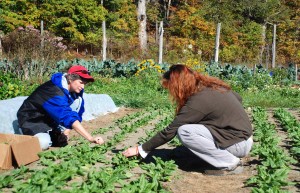Friday
Featured StoriesTaking Our Seats as Earth Protectors
By Sue Gilman and Fred Meyer for the Dot
Touching the Earth, Shambhala’s working group on the environment and sustainability, came together in person for the first time in November for a retreat at Karmê Chöling. Officially born at the 2006 Congress in Cologne, the group has been meeting, as do most working groups, via conference calls and email. “It was a great inspiration to sit down together face to face to assess what we’ve accomplished and plan how we can move to the next level,” said Jessyca Goldstein, Chair of Touching the Earth, “It was remarkable how helpful it was to actually be in the same room!”
Relating to Our Mess
The group’s first action last spring was to create a “sustainability survey” for Shambhala Centers. “We wanted to find out what our Centers are already doing as a basis for understanding how we could be useful,” Jessyca said. The survey has been completed by thirteen Centers so far and it comes as no surprise that our community is a wealth of riches, experience, ideas, and frustrations. One question in the survey was about obstacles to accomplishing sustainability goals at Centers. The responses were pretty consistent: money, time and resources.
The survey also revealed that many Centers are already hard at work reducing their impact on the environment. In every single survey there was concern about how to deal with the mess we create as a result of receptions and feasts – a common challenge in Shambhala society. In Berkeley, some of the program coordinators use compostable tableware (plates, utensils, cups), and then take them home to their personal compost piles. At the Shelburne Falls Center in Massachusetts, they use conventional tableware for community meals and wash the dishes, avoiding disposables altogether.
Many Centers reported that they are either already using green cleaning products or researching what makes the most sense. Most Centers are recycling paper, using compact fluorescent bulbs and turning off lights. A number of Centers have more sophisticated programs in place to achieve even greater reduction of their impact on the environment.
The Halifax Shambhala Center has put together a Sustainability Initiative that is also being adopted by other Centers. One of those is the Durham Center, whose Directors have been instrumental in supporting environmental awareness. When purchasing products, they ask a series of questions: Do we really need this item? Can we borrow, rent, or purchase it second-hand? Does the Center already have one of these tucked away somewhere? If it’s determined the product is needed, they ask: Is it made of recycled material? Is it high quality for longer use, easy to fix or maintain? Were toxic materials used to make it, or will it be toxic when we use or dispose of it? Where will it go when we’re done with it? Will it sit in a landfill for years?
All of the land centers are developing more extensive systems for reducing their impact on the environment. At Shambhala Mountain Center, the recycling program now includes Styrofoam, fluorescent lighting and computers. The kitchen makes some of its own food (granola, bread, salad dressings) and is buying locally whenever possible. In addition to buying more organic meat, they have built a root cellar, where they will store organic vegetables for use during the winter months.
Karmê Chöling has had an organic garden for many years, and is expanding sustainability efforts by buying more food locally and offering Fair Trade coffee. In addition, Karmê Chöling has recently become a member of the Vermont Fresh Network. All the windows at the Ashoka Bhavan guesthouse have been upgraded to double-pane storm windows, as have some windows in the main building. Dorje Denma Ling installed composting toilets with solar powered lighting. They replaced the oil furnace with a geothermal heating system during the renovation of the barn. And they turn off all electronics every night!
When Sky Lake Lodge was purchased in 2001, it was already a model of sustainability. The decks around the building are made of recycled material and all the wood used in its renovation came from trees on the land that were milled locally.
Who Are We?
Touching the Earth’s thirteen members have a broad range of experience. Some are veterans of environmental and social issues, while others are experiencing the challenges of creating change for the first time. Some have been practicing and teaching in Shambhala for many years, while others are new to the community.
One topic of discussion for the group has been: “What makes us unique?’ What makes this group different from any other environmental group? In Shambhala, the view of sacred world and the teachings on interdependence and impermanence are the ground of our reality. We have the teachings of the three yanas and drala. We meditate and we contemplate. We have also been given the challenge of creating enlightened society. These certainly distinguish us from other groups. One of the challenges for Touching the Earth is to skillfully incorporate these unique teachings into sustainable practices.
“The retreat was an opportunity to delve more deeply and personally into both what makes us unique and how we can serve, not only the Shambhala community, but also the larger world.” Leila Bruno said. A working mission statement has been adopted: Our mission is to work towards Shambhala becoming a powerful force for societal transformation in accordance with the principles and practices of both warriorship and sustainability. Since we train to join heaven and earth every day, Touching the Earth feels the necessary tools have already been provided. Now it’s time to “just do it.”
Where We’re Headed
Initiatives are underway to identify the teachings of both the Vidyadhara and the Sakyong that directly address the relationship between Shambhala Warriorship and sacred world, specifically focusing on the earth. We have begun a conversation with the Office of Practice and Education, as well as many of the Acharyas and other senior teachers, about incorporating more ecologically oriented teachings into our curriculum. A web presence is underway and a decision was made to add new members to the working group.
Three subcommittees have been formed: a Communications Committee, the View/ Teachings Committee, and the Authentic Actions Committee. The Authentic Actions Committee’s primary focus will be on best practices and developing a resource library. There are already thirty-two liaisons from Shambhala Centers around the world, who are a powerful resource for sharing information and strengthening communication, and that number is expected to grow.
In addition, Touching the Earth has begun to supplicate Sakyong Mipham Rinpoche to write a sadhana for the earth, and is committed to developing the skillful means to create the right atmosphere for that to manifest.
In the winter issue of Buddharma magazine, David Loy and John Stanley called for an international gathering of Buddhist leaders to address the ecological crisis facing our planet. Touching the Earth brought this call for action to the attention of the Sakyong’s Council, suggesting that Shambhala not only become involved, but also consider offering to host the event. The Sakyong’s Council welcomed the idea and appointed Mr. Marty Janowitz, a member of Touching the Earth, to represent Shambhala in this effort. Marty has had a conversation with John Stanley and offered our support and assistance. Venues are being discussed and the organizers are supplicating both His Holiness the Dalai Lama and His Holiness Karmapa for their guidance and participation.
The Touching the Earth Group feels it is important to go deep and be clear. There is consensus to beware of the pitfall of “greenwashing” – attempting ecological initiatives for the sake of appearance or because it is the latest fad. While recognizing there is much to be done, the group also understands the importance of not giving in to feeling overwhelmed. Touching the Earth looks forward to the input and participation of Shambhala warriors all over the planet as we discover together the role for each of us as earth protectors.
Members of the Touching the Earth Working Group include Jessyca Goldstein, Chair; Marty Janowitz, JoAnn Carmin, Leila Bruno, Adam Pattantyus, Tracy Suchocki, Olivia Kirby, David Wimberly, Laura Skutch, Courtney Greenawalt, David Delcourt, Citlalli Peña, Sue Gilman.



















Feb 26, 2009
Reply
How do people get involved in this?